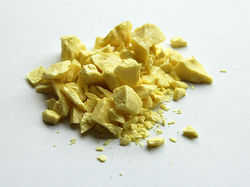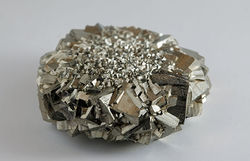Difference between revisions of "Sulfur"
| (12 intermediate revisions by the same user not shown) | |||
| Line 1: | Line 1: | ||
[[File:Sulfur-sample - Pub dom.jpg|250px|thumb|right|Sulfur]] | [[File:Sulfur-sample - Pub dom.jpg|250px|thumb|right|Sulfur]] | ||
| + | [[File:Pyrite - Wikimedia Commons.jpg|250px|thumb|right|Crystals of pyrite (iron sulfide)]] | ||
Sulfur is the chemical element with atomic number 16. In the periodic table it is represented by the symbol S. It is an abundant, multivalent non-metal.<br> | Sulfur is the chemical element with atomic number 16. In the periodic table it is represented by the symbol S. It is an abundant, multivalent non-metal.<br> | ||
S is created inside massive stars and, usually as sulfide, is present in many types of meteorites. On Earth, elemental sulfur can be found near hot springs and volcanic regions in many parts of the world. | S is created inside massive stars and, usually as sulfide, is present in many types of meteorites. On Earth, elemental sulfur can be found near hot springs and volcanic regions in many parts of the world. | ||
| Line 6: | Line 7: | ||
== Sulfur as nutrient for plants == | == Sulfur as nutrient for plants == | ||
| − | Sulfur is increasingly used as a component of fertilizers. The most important form of sulfur for fertilizer is the mineral calcium sulfate. Elemental sulfur is not soluble in water and cannot be directly utilized by plants. Over time, soil bacteria convert it to soluble derivatives, which can then be utilized by plants. Sulfur improves the use efficiency of other essential plant nutrients, particularly nitrogen and phosphorus. Biologically produced sulfur particles are naturally hydrophilic ( | + | Sulfur is increasingly used as a component of fertilizers. The most important form of sulfur for fertilizer is the mineral calcium sulfate. Elemental sulfur is not soluble in water and cannot be directly utilized by plants. Over time, soil bacteria convert it to soluble derivatives, which can then be utilized by plants. Sulfur improves the use efficiency of other essential plant nutrients, particularly nitrogen and phosphorus. Biologically produced sulfur particles are naturally hydrophilic (attracted to and dissolved by water) due to a biopolymer coating. This sulfur is, therefore, easier to disperse over the land (via spraying as a diluted slurry), and results in a faster release. |
Sulfur is one of the major nutrients essential for plant growth, root nodule formation of legumes and plants protection mechanisms. Sulfur deficiency has become widespread in many countries in Europe. Because atmospheric inputs of sulfur will continue to decrease, the deficit in the sulfur input/output is likely to increase, unless sulfur fertilizers are used.<ref>[http://en.wikipedia.org/wiki/Sulfur#Fertilizer Sulfur - Fertilizer - Wikipedia]</ref> | Sulfur is one of the major nutrients essential for plant growth, root nodule formation of legumes and plants protection mechanisms. Sulfur deficiency has become widespread in many countries in Europe. Because atmospheric inputs of sulfur will continue to decrease, the deficit in the sulfur input/output is likely to increase, unless sulfur fertilizers are used.<ref>[http://en.wikipedia.org/wiki/Sulfur#Fertilizer Sulfur - Fertilizer - Wikipedia]</ref> | ||
| + | |||
| + | === Symptoms of sulfur deficiency in plants === | ||
| + | Sulfur deficiency may not be recognized easily in the field, as the symptoms are not obvious except in severely deficient plants. Sulfur deficiency results in a uniform pale green chlorosis (a condition in which leaves produce insufficient chlorophyll) throughout the plant. Veins do not retain a green color.<br> | ||
| + | A considerable reduction in growth may be suffered without the appearance of any visible symptoms. Clear symptoms are associated with severe stunting, accompanied by reduced leaf size, and reduced activity of axillary buds, resulting in less branching.<br> | ||
| + | Purple or red-brown pigmentation may develop on both young and old leaves. Leaves of intermediate age generally lack purple pigmentation. In plants which normally have purple-pigmented shoot tips, pigment is lost in the normal manner as leaves mature (in contrast with nitrogen deficiency). <br> | ||
| + | : ''See [http://keys.lucidcentral.org/keys/sweetpotato/key/Sweetpotato%20Diagnotes/Media/Html/TheProblems/MineralDeficiencies/SulfurDeficiency/S%20deficiency.htm Sulfur deficiency] for photos and more information.'' | ||
== Sulfur as nutrient in food == | == Sulfur as nutrient in food == | ||
| Line 16: | Line 23: | ||
Sulfur is present in animal and vegetable proteins such as meat, poultry, beans and pulses and shellfish. | Sulfur is present in animal and vegetable proteins such as meat, poultry, beans and pulses and shellfish. | ||
| − | '''Sulfites''' (compounds that contain the sulfite SO<sub>3</sub><sup>2-</sup> are often used as preservatives in dried fruits, preserved radish, and dried potato products. Sulfites occur naturally in most wines to some extent. Sulfites are commonly introduced to arrest fermentation at a desired time, and may also be added to wine as preservatives to prevent spoilage and oxidation at several stages of the winemaking. | + | '''Sulfites''' (compounds that contain the sulfite SO<sub>3</sub><sup>2-</sup>) are often used as preservatives in dried fruits, preserved radish, and dried potato products. Sulfites occur naturally in most wines to some extent. Sulfites are commonly introduced to arrest fermentation at a desired time, and may also be added to wine as preservatives to prevent spoilage and oxidation at several stages of the winemaking. |
| − | '''Sulfur dioxide''' ( | + | '''Sulfur dioxide''' (SO<sub>2</sub>, sulfur with two atoms of oxygen) protects wine from not only oxidation, but also bacteria. Without sulfur, [[grape]] juice would turn to vinegar.<ref>[http://en.wikipedia.org/wiki/Sulfite Sulfite - Wikipedia]</ref> |
== References == | == References == | ||
| Line 30: | Line 37: | ||
[[Category:Minerals]] | [[Category:Minerals]] | ||
[[Category:Nutrients for plants]] | [[Category:Nutrients for plants]] | ||
| + | [[Category:Viticulture]] | ||
Latest revision as of 04:11, 22 January 2012
Sulfur is the chemical element with atomic number 16. In the periodic table it is represented by the symbol S. It is an abundant, multivalent non-metal.
S is created inside massive stars and, usually as sulfide, is present in many types of meteorites. On Earth, elemental sulfur can be found near hot springs and volcanic regions in many parts of the world.
In the past, sulfur was mostly mined in various ways, for example extracted from pyrite (iron sulfide). Today's sulfur production is as a side product of other industrial processes such as oil refining.
Sulfur as nutrient for plants
Sulfur is increasingly used as a component of fertilizers. The most important form of sulfur for fertilizer is the mineral calcium sulfate. Elemental sulfur is not soluble in water and cannot be directly utilized by plants. Over time, soil bacteria convert it to soluble derivatives, which can then be utilized by plants. Sulfur improves the use efficiency of other essential plant nutrients, particularly nitrogen and phosphorus. Biologically produced sulfur particles are naturally hydrophilic (attracted to and dissolved by water) due to a biopolymer coating. This sulfur is, therefore, easier to disperse over the land (via spraying as a diluted slurry), and results in a faster release.
Sulfur is one of the major nutrients essential for plant growth, root nodule formation of legumes and plants protection mechanisms. Sulfur deficiency has become widespread in many countries in Europe. Because atmospheric inputs of sulfur will continue to decrease, the deficit in the sulfur input/output is likely to increase, unless sulfur fertilizers are used.[1]
Symptoms of sulfur deficiency in plants
Sulfur deficiency may not be recognized easily in the field, as the symptoms are not obvious except in severely deficient plants. Sulfur deficiency results in a uniform pale green chlorosis (a condition in which leaves produce insufficient chlorophyll) throughout the plant. Veins do not retain a green color.
A considerable reduction in growth may be suffered without the appearance of any visible symptoms. Clear symptoms are associated with severe stunting, accompanied by reduced leaf size, and reduced activity of axillary buds, resulting in less branching.
Purple or red-brown pigmentation may develop on both young and old leaves. Leaves of intermediate age generally lack purple pigmentation. In plants which normally have purple-pigmented shoot tips, pigment is lost in the normal manner as leaves mature (in contrast with nitrogen deficiency).
- See Sulfur deficiency for photos and more information.
Sulfur as nutrient in food
Sulfur is an essential component of all living cells. It is the seventh or eighth most abundant element in the human body by weight. Sulfur can eliminate toxins from the body. Sulfur may delay the aging process and the onset of any age-related diseases.[2]
Sulfur is present in animal and vegetable proteins such as meat, poultry, beans and pulses and shellfish.
Sulfites (compounds that contain the sulfite SO32-) are often used as preservatives in dried fruits, preserved radish, and dried potato products. Sulfites occur naturally in most wines to some extent. Sulfites are commonly introduced to arrest fermentation at a desired time, and may also be added to wine as preservatives to prevent spoilage and oxidation at several stages of the winemaking.
Sulfur dioxide (SO2, sulfur with two atoms of oxygen) protects wine from not only oxidation, but also bacteria. Without sulfur, grape juice would turn to vinegar.[3]
References
External links
- Sulfite - Wikipedia
- Sulfur Wikipedia


